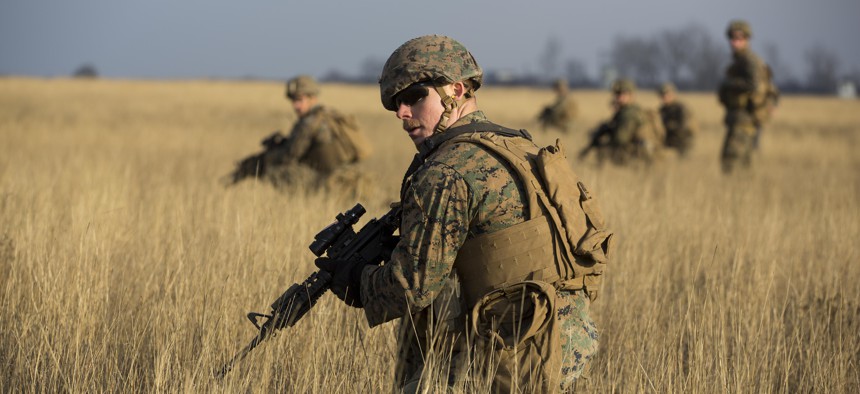
U.S. Marines train with Romanian and Moldovan forces in Romania in December 2015. U.S. Marine Corps / Lance Cpl. Melanye E. Martinez
NATO Needs to Move Two Brigades East, and That’s Just a Start
The world is changing around the alliance; here's what its leaders must do to keep up.
Two years ago, Russia annexed Crimea — and demonstrated why NATO still matters. This week, Russia’s President Vladimir Putin surprised the world again by calling most of his troops home from Syria, leaving us to wonder what his next move might be. Will he focus on Ukraine again, or will he get involved somewhere else in Europe’s south? No matter where he goes, the Alliance needs to make sure it has a credible response. Here are four things NATO needs to do when its leaders gather at their Warsaw Summit in July.
First, place two brigades on its Eastern flank. As it is postured today, NATO is unable to easily defend its most vulnerable allies. In a conflict, Russian anti-access and area-denial capabilities in Kaliningrad could block allied air support while Moscow pours superior forces through Poland’s Suwalki Gap to cut off the Baltics. This kind of large-scale land attack is a low-probability, but extremely high-impact scenario. And Russia means business, as it has shown with the annexation of Crimea, the war in Eastern Ukraine, and its intervention in Syria. So the Warsaw Summit must shift Alliance strategy from small, mobile reinforcement to a larger, more autonomous forward presence with key capabilities in air defense, intelligence, surveillance, reconnaissance, and electronic warfare. Considering the overwhelming Russian military force ratio in the region, rotating a force the size of an Allied brigade, one in the Baltics and one in Poland, would be a good start.
Second, develop a clear strategy toward the South. The Mediterranean and the Levant remain sources of durable chaos that affect the security of NATO allies – witness the terrorist attacks in Paris and Ankara. Even if Russia’s withdrawal persuades Assad to compromise during the Syrian peace negotiations, it’s not going to solve the broader meltdown of the state system in MENA, which will continue to be a source of angst for the Alliance in the years to come. In Warsaw, Allies can approve a number of steps to strengthen their posture in the region. First, improve warning, surveillance, and response against trafficking in the eastern and central Mediterranean by flying Global Hawk UAVs from Sicily’s Sigonella Naval Air Station. Next, create initiatives to deter threats to Turkey’s security and territorial integrity, including the Russian military presence in the region. Although Moscow is withdrawing most forces from Syria, it sustains a strong footprint in the Eastern Med through its naval base in Latakia and airfield in Tartus. Finally, increase political support and resources to NATO’s Mediterranean Dialogue and the Istanbul Cooperation Initiative, which can draw upon substantial — and often unrecognized — openness and willingness in the Arab region for greater cooperation with the Alliance.
Third, focus on hybrid threats. Today, Russia represents mainly a conventional threat, but it and others are wading further into cyber and info warfare. NATO cannot present a united front if certain allies feel inadequately protected in this domain. The Warsaw Summit can set the Alliance on the right path by increasing human capital and financial resources for NATO’s various civil and military intelligence units, by granting the Supreme Allied Commander Europe more powers to authorize some of the preparatory response procedures, and above all, by working more closely with the European Union, such as seeking a NATO-EU Memorandum of Understanding on hybrid warfare.
Fourth, update its nuclear policy. The doctrine and conditions for crisis management enshrined in the 2012 Deterrence and Defense Posture Review are no longer valid. Russia considers nuclear weapons to be an integral part of its military power and increasingly uses its nuclear posture for messaging. The settlement with Iran may have brought a compromise with Teheran, but the agreement further permits the enrichment of nuclear material and thereby keeps the option of clandestine weapons grade material open. As for North Korea, it is pursuing its nuclear weapons program despite international sanctions. At the Warsaw Summit, the allies should therefore agree on wording that highlights the need for nuclear deterrence against any threat to NATO territory. After the Summit, NATO should launch a more comprehensive debate on its nuclear forces, akin to the process that led to the 2012 Deterrence and Defense Posture Review.
This is an ambitious agenda, but small, incremental changes will not answer the new security landscape in which the Allies find themselves. And this list is just a beginning. For more thoughts, see our new report, “NATO in A World of Disorder: Making the Alliance Ready for Warsaw.”



